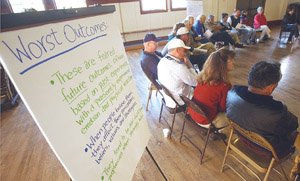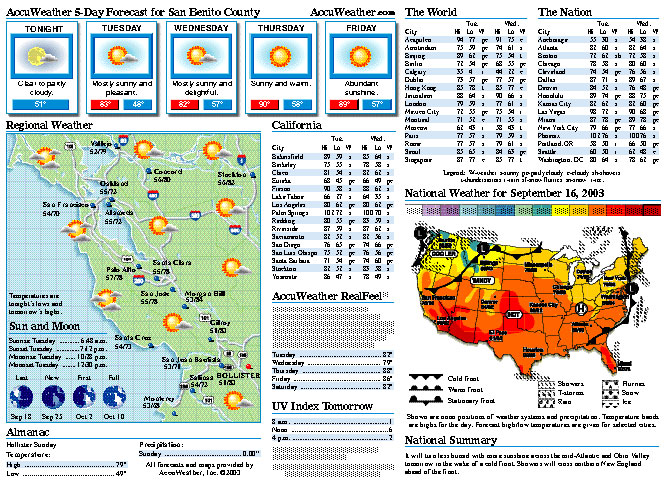
The future of San Benito County was deemed important enough by
about 40 county residents to sacrifice a Saturday.
The third San Benito County Consensus Building workshop to
discuss future growth and development in the county
– specifically Measure G, or the Growth Control Initiative – was
an all-day event held at the San Juan Bautista Community
Center.
The workshops have been put on during the past several months by
San Juan Bautista ranchers Joe and Julie Morris to help cultivate
communication between the proponents and opponents of the
measure.
The future of San Benito County was deemed important enough by about 40 county residents to sacrifice a Saturday.
The third San Benito County Consensus Building workshop to discuss future growth and development in the county – specifically Measure G, or the Growth Control Initiative – was an all-day event held at the San Juan Bautista Community Center.
The workshops have been put on during the past several months by San Juan Bautista ranchers Joe and Julie Morris to help cultivate communication between the proponents and opponents of the measure.
Saturday’s workshop garnered farmers, ranchers, business owners, appraisers and concerned community members from all around the county, as well as some from outside of the county. Pat Loe was the lone representative from the Board of Supervisors who attended.
“It’s frustrating that we have to be here on a Saturday,” Julie Morris said. “I’d rather be with my kids or working in my garden, but I think it’s important that we are here and committed to finding a solution to the problems we are facing.”
Measure G, which will be voted on in March, has created a rift between landowners who believe the measure is violating their rights to subdivide their holdings, and land conservationists who are trying to preserve it.
Three facilitators from Glenn County moderated the meeting, expediting discourse in the form of large-group discussion and small-group synthesis.
“Overall, we continue to work on trust,” said Lorri Pride, the chief facilitator and principal of Pride Consulting Services. “People want to continue to educate on Measure G so the community can make an informed decision on it.”
Educating the community and discussing alternatives to the measure were paramount topics of discussion.
One specific concern that garnered a considerable amount of dialogue was whether the land trying to be preserved is viable agricultural land or open space, and the significance that distinction has on local landowners.
The difference between agricultural land and open space has a lot to do with preserving viable farms, Joe Morris said. If local farmers can’t make a living in the county, instead of having medium-sized farmers utilizing the benefits of the land, large corporate farmers will take over the business, he said.
“Open space is a misnomer,” he said. “Somebody will be farming, but it most likely won’t be the moderate family farms which are the backbone of San Benito County.”
The rhythm of Saturday’s workshop was very similar to the past workshops, Joe Morris said.
“In the morning, there was quite a bit of anger and anxiety,” he said. “But the focus of the meeting is always on the best possible outcomes, so we took the very expressions of anger and anxiety and used it to produce little steps towards (that).”
Several of the best possible outcomes brainstormed while in small groups were: Land use policies having more flexibility, a slow pace of growth to better manage growth, cohesive cooperation by the community and that people look for long-term solutions that work for everyone.
Worst possible outcomes included: People believing their perspective is the only truth, the community division continues, lawsuits and that the younger generation will be forced to leave the county because of a lack of opportunities.
Being cognizant of each individual’s idea of what the truth of the matter is and how to better understand why they believe those truths was a major focus of the workshop.
“If we’re going to have productive dialogue we have to seek the truth, we have to be honest,” said Richard Saxe, part of the Citizens for Responsible Growth and one of the drafters of the initiative. “I personally cannot tolerate any more lies, but I will remain hopeful.”
Tom Tobias, president of the Farm Bureau, expressed his personal hope that the group could formulate an agreement that would suit parties from both sides.
“I’ve tried to play by the rules,” he said. “I’d like to see a nice settlement out of this situation.”
At the end of the workshop, Loe volunteered to get the main players of both sides together within the next couple weeks to attempt to come to some concrete agreements.
“I approached both sides about seeing if they would like to send a representative to iron out the more unpalatable sections of the initiative,” she said.
Breaking it down into a smaller, more informed group is the only way to heal the rift created by the initiative, Loe said.
“I don’t think it’s going to happen at the workshops,” she said. “We have to get into smaller groups and hammer out some kind of agreement.”
While everyone present agreed the workshops are helpful in facilitating communication, it’s what comes out of them in the next few months that will really matter, said Anthony Bothelo, an orchardist and vehement opponent of Measure G, who is running for the Board of Supervisors in March.
“I’ve been to three consensus workshops and feel that we’re building some sort of dialogue, but nothing constructive has come out of them as of yet,” Bothelo said. “I’m optimistic…hopefully with the input that happened, a couple months down the road there will be an acknowledgment of each parties’ concerns. And that will only come in time.”
There will probably never be a real consensus concerning Measure G, Joe Morris said, but they can come to a consensus about the future of San Benito County.
“There’s a fairly well-shared vision of what we want San Benito County to become,” he said. “Almost everyone is looking at the long-term, and how to produce the best possible outcome for the county.”







